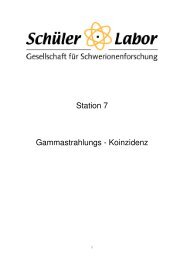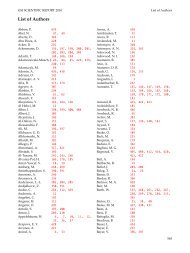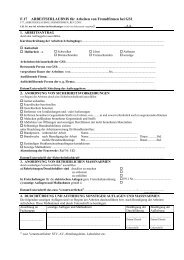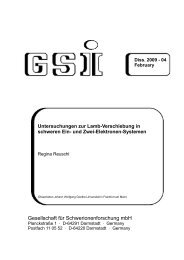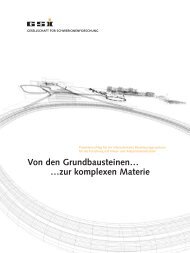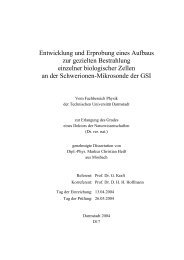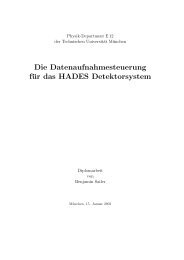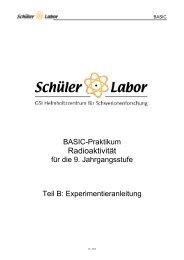CBM Progress Report 2006 - GSI
CBM Progress Report 2006 - GSI
CBM Progress Report 2006 - GSI
You also want an ePaper? Increase the reach of your titles
YUMPU automatically turns print PDFs into web optimized ePapers that Google loves.
<strong>CBM</strong> <strong>Progress</strong> <strong>Report</strong> <strong>2006</strong> Detector Developments<br />
Layout studies of the <strong>CBM</strong> Silicon Tracking System<br />
J. M. Heuser 1 , R. Karabowicz 1 , and E. Kryshen 2<br />
1 <strong>GSI</strong>, Darmstadt, Germany; 2 St. Petersburg State Polytechnic University, Russia<br />
The Silicon Tracking System (STS) is the central<br />
detector of the <strong>CBM</strong> experiment. It serves for track and<br />
momentum measurement of all charged particles produced<br />
in nuclear reactions at the target. Au+Au collisions at<br />
FAIR energies generate up to 1000 charged particles whose<br />
tracks have to be efficiently reconstructed with about 1%<br />
momentum resolution [1]. This task requires a low-mass<br />
silicon tracking detector system of high granularity. We<br />
are studying the layout of tracking stations made from thin<br />
micro-strip and pixel detectors, and their arrangement in a<br />
dipole magnetic field of 1 Tm bending power.<br />
Detector Concept<br />
The STS concept, schematically shown in Fig. 1, comprises<br />
6 detector stations for the track measurement. Two<br />
stations may consist of LHC-type hybrid pixel detectors.<br />
Those are relatively thick and presumably require active<br />
cooling in the aperture, but contribute with unambiguous<br />
space points to the track finding where the track densities<br />
are high. For the remaining four stations, low-mass<br />
micro-strip detectors are considered to perform the track<br />
point measurement. The projective coordinate measurement<br />
of the sensors leads to a significant fraction of combinatorial<br />
or fake hits, a challenge to the reconstruction algorithms.<br />
However, the application of micro-strip sensors<br />
may lead to particularly low-mass stations if their powerconsuming<br />
readout electronics can be placed outside of the<br />
STS aperture, a current R&D effort reported in [2] and [3].<br />
For high-resolution vertex measurements, e.g. open charm<br />
detection, the STS is supported with a Micro-Vertex<br />
Detector (MVD) consisting of two very thin and fine-pitch<br />
MAPS pixel detector stations close to the target.<br />
Figure 1: Schematics of the STS + MVD detector systems.<br />
29<br />
Performance Studies<br />
We implemented the detector stations in the simulation<br />
framework <strong>CBM</strong>ROOT as discs of silicon, with<br />
a thickness equivalent to the total average material expected<br />
from a real detector. During the hit digitization,<br />
a specific detector structure was projected onto the<br />
volumes. The hybrid pixel stations were segmented into<br />
50×50 µm 2 pixels. The micro-strip stations were made<br />
from double-sided sensors segmented into strips of 50 µm<br />
pitch with a 15 degree stereo angle between front and back<br />
side. Central 25 GeV/nucleon Au+Au collisions from the<br />
URQMD generator were transported through the detector<br />
and reconstructed with a cellular automaton for track<br />
finding and a Kalman filter for track fitting [1]. Reconstruction<br />
efficiencies of about 97% (92%) for primary (all)<br />
tracks exceeding 1 GeV/c momentum, and a momentum<br />
resolution between 1% and 2% depending on the detector<br />
thickness (assessed in a parameter study, see Table 1)<br />
demonstrate the feasibility of the track measurement with<br />
the proposed detector concept.<br />
Table 1: Momentum resolution ∆p/p as a function of the<br />
effective detector thickness.<br />
Layout Iterations<br />
Current performance studies investigate the effects of<br />
different strip lengths and stereo angles on the track reconstruction.<br />
We also study detector configurations where e.g.<br />
the hybrid pixel stations are replaced with pairs of microstrip<br />
stations slightly rotated against each other. Next steps<br />
will focus on more complex and realistic implementations<br />
of the STS. This includes detailed geometrical models of<br />
the tracking stations, built from sensor wafers arranged into<br />
modular structures and mounted on mechanical supports.<br />
References<br />
[1] I. Kisel et al., Event Reconstruction in the <strong>CBM</strong> Experiment,<br />
this report<br />
[2] J. M. Heuser et al., <strong>GSI</strong> document DOC-<strong>2006</strong>-Dec-19<br />
[3] J. M. Heuser et al., Development of Microstrip Sensors for the<br />
<strong>CBM</strong> Silicon Tracking System, this report



